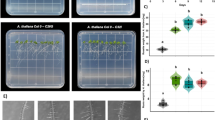Abstract
Plant resistance to insect herbivory involves gene expression in response to wounding and the detection of insect elicitors in oral secretions (Kessler and Baldwin, 2002, Ann. Rev. Plant/ Biol. 53: 299–328). However, crawling insect larvae stimulate the synthesis of 4-aminobutyrate within minutes and imprints of larval footsteps can be visualized within seconds through superoxide production or transient increases in chlorophyll fluorescence (Bown et al., 2002, Plant Physiol. 129: 1430–1434). Here cryo-scanning electron microscopy was used to demonstrate that larval feet, which are equipped with a perimeter row of hook-like crochets, damage leaf tissue and result in larval footprints. Staining for cell death shows that areas of wounding correspond to footsteps detected through increased chlorophyll fluorescence. Superoxide production in response to footsteps was inhibited by diphenyleneiodonium, an inhibitor of the plasma membrane NADPH oxidase enzyme. Inhibition of superoxide production, however, did not eliminate the detection of cell death. The results demonstrate that larval footsteps damage leaf tissue, and initiate rapid local responses which are not dependent on herbivory or oral secretions. It is proposed that superoxide production at the wound site prevents opportunistic pathogen infection.
Similar content being viewed by others
References
Bi JL and Felton GW (1995) Foliar oxidative stress and insect herbivory: Primary compounds, secondary metabolites, and reactive oxygen species as components of induced resistance. Journal of Chemical Ecology 21: 1511–1530.
Bi JL, Murphy JB and Felton GW (1997) Antinutritive and oxidative components as mechanisms of induced resistance in cotton to Helicoverpa zea. Journal of Chemical Ecology 23: 97–117.
Bown AW, Hall DE and MacGregor KB (2002) Insect footsteps on leaves stimulate the accumulation of 4-aminobutyrate and can be visualized through increased chlorophyll fluorescence and superoxide production. Plant Physiology 129: 1430–1434.
Casida JE (1993) Insecticide action at the GABA-gated chloride channel: Recognition, progress and prospects. Archives of Insect Biochemistry and Physiology 22: 13–23.
Chapman RF (1969) Locomotion. In: The Insects. American Elsevier Publishing Company, Inc., New York, pp. 154–157.
Chico JM, Raíces M, Téllez-Iñón MT and Ulloa RM (2002) A calcium-dependent protein kinase is systemically induced upon wounding in tomato plants. Plant Physiology 128: 256–270.
Conconi A, Miquel M, Browse JA and Ryan CA (1996) Intracellular levels of free linolenic and linoleic acids increase in tomato leaves in response to wounding. Plant Physiology 111: 797–803.
Creelman RA, Tieney ML and Mullet JE (1992) Jasmonic acid/methyl jasmonate accumulate in wounded soybean hypocotyls and modulate wound gene expression. Proceeding of the National Acadamy of Science USA 89: 4938–4941.
Desikan R, Hancock JT, Coffey MJ and Neill SJ (1996) Generation of active oxygen in elicited cells of Arabidopsis thaliana is mediated by a NADPH oxidase-like enzyme. FEBS Letters 382: 213–217.
Felton GW, Bi JL, Summers CB, Mueller AJ and Duffey SS (1994) Potential role of lipoxygenases in defense against insect herbivory. Journal of Chemical Ecology 20: 651–666.
Gaff DF and Okong'O-Ogola O (1971) The use of non-permeating pigments for testing the survival of cells. Journal of Experimental Botany 22: 756–758.
Hammond-Kosack KE and Jones JDG (1996) Resistance gene-dependent plant defense responses. Plant Cell 8: 1773–1791.
Jabs T, Dietrich RA and Dangl JL (1996) Initiation of runaway cell death in an Arabidopsis mutant by extracellular superoxide. Science 273: 1853–1856.
Keller T, Damude HG, Werner D, Doerner P, Dixon RA and Lamb C (1998) A plant homolog of the neutrophil NADPH oxidase gp91phox subunit gene encodes a plasma membrane protein with Ca2+ binding motifs. Plant Cell 10: 255–266.
Kessler A and Baldwin IT (2002) Plant responses to insect herbivory: The emerging molecular analysis. Annual Review of Plant Biology 53: 299–328.
Lüthje S, Böttger M and Döring O (2000) Are plants stacked neutrophiles? Comparison of pathogen-induced oxidative burst in plants and mammals. Progress in Botany 61: 187–222.
McLean MD, Yevtushenko DP, Deschene A, Cauwenberghe ORV, Makhmoudova A, Potter JW, Bown AW and Shelp BJ (2003) Transgenic tobacco plants overexpressing glutamate decarboxylase are resistant to the root-knot nematode. Molecular Breeding 11: 277–285.
Orozco-Cardenas M and Ryan CA (1999) Hydrogen peroxide is generated systemically in plant leaves by wounding and systemin via the octadecanoid pathway. Proceedings of National Acadamy of Science USA 96: 6553–6557.
Ramputh AI and Bown AW (1996) Rapid γ-aminobutyric acid synthesis and the inhibition of the growth and development of oblique-banded leaf-roller larvae. Plant Physiology 111: 1349–1352.
Ryan CA (2000) The systemin signaling pathway: Differential activation of plant defensive genes. Biochimica and Biophysica Acta 1477: 112–121.
Sattelle DB (1990) GABA receptors of insects. Advances in Insect Physiology 22: 1–113.
Wallace W, Secor J and Schrader LE (1984) Rapid accumulation of γ-aminobutyric acid and alanine in soybean leaves in response to an abrupt transfer to lower temperature, darkness, or mechanical manipulation. Plant Physiology 75: 170–175.
Wojtaszek P (1997) Oxidative burst: An early plant response to pathogen infection. Biochemical Journal 322: 681–692.
Author information
Authors and Affiliations
Rights and permissions
About this article
Cite this article
Hall, D.E., MacGregor, K.B., Nijsse, J. et al. Footsteps from Insect Larvae Damage Leaf Surfaces and Initiate Rapid Responses. European Journal of Plant Pathology 110, 441–447 (2004). https://doi.org/10.1023/B:EJPP.0000021072.89968.de
Issue Date:
DOI: https://doi.org/10.1023/B:EJPP.0000021072.89968.de




